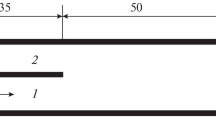Abstract
Experimental investigation on rheoreaction as a behavioral mechanism in the formation of phenotypic groups of underyearlings of the Atlantic salmon Salmo salar is performed. Juveniles of the Atlantic salmon are investigated at the age 0+ from the coastal group and from the tributary group in the period of its primary distribution from redds. The underyearlings from the tributary group differ from the coastal fish in increased critical current velocity, the fact that among them the most portion of individuals have a positive type of rheoreacrtion, and the fact that they prefer currents more often. The behavioral mechanism of spatial separation of the spreading juveniles at confluence of two currents is revealed: stronger individuals with the positive type of rheoreaction and the expressed rheopreferendum mainly move against the flow at a higher speed and manage to get into a tributary. The weaker fish with static and negative dynamic types of rheoreaction, having no expressed rheopreferendum, prefer the flow with lower current rate and turn out to be in the coastal zone of the mainstream.
Similar content being viewed by others
References
I. A. Baryshev, “Amphibiotic Insects of Rearing Sites of Juvenile Atlantic Salmon in the Varzuga River Basin,” in Materials of II All-Russia Symposium on Amphibiotic and Aquatic Insects (Voronezh, 2004), pp. 7–13.
J. E. Hensleigh and A. P. Hendry, “Rheotactic Response of Fry from Beach-Spawning Populations of Sockeye Salmon: Evolution After Selection Is Relaxed,” Can. J. Zool., No. 76, 2186–2193 (1998).
R. V. Kazakov, Biological Foundations of Cultivation of Atlantic Salmon (Leg. i Pishch. Prom-st’, Moscow, 1982) [in Russian].
N. B. Metcalfe, F. A. Huntingford, and J. E. Thorpe, “Social Effects on Appetite and Development in Atlantic Salmon,” World Aquacult. Workshops, No. 2, 29–40 (1992).
D. S. Pavlov, Biological Foundations of Control of Fish Behavior in a Water Flow (Nauka, Moscow, 1979) [in Russian].
D. S. Pavlov, A. I. Lupandin, and V. V. Kostin, Mechanisms of Downstream-Migrating Juveniles of River Fish (Nauka, Moscow, 2007a) [in Russian].
D. S. Pavlov, O. V. Meshcheryakova, A. E. Veselov, et al., “Parameters of Energy Metabolism in Juveniles of Atlantic Salmon (Salmo salar) Living in the Mainstream and in the Tributary of the Varzuga River (the Kola Peninsula),” Vopr. Ikhtiol. 47(6), 819–826 (2007b) [J. Ichthyol. 47 (9), 774–781 (2007b)].
D. S. Pavlov, Z. A. Nefedova, A. E. Veselov, et al., “Lipid Status of Fingerlings of the Atlantic Salmon Salmo salar from Different Microbiotopes of the Varzuga River,” Vopr. Ikhtiol. 48(5), 679–685 (2008) [J. Ichthyol. 48(8), 648–654 (2008)].
D. S. Pavlov, V. V. Kostin, and V. Yu. Ponomareva, “Behavioral Differentiation of Fingerlings of Black Sea Trout Salmo trutta labrax: Rheoreaction in a Year Preceding Smoltification,” Vopr. Ikhtiol. 50(2), 251–261 (2010).
D. S. Pavlov, Z. A. Nefedova, A. E. Veselov, et al., “Age Dynamics of Lipid Status of Juveniles of Atlantic Salmon (Salmo salar L.) from the Varzuga River,” J. Ichthyol. 49(11), 1037–1080 (2009).
Yu. A. Shustov, Ecology of Juvenile Atlantic Salmon (Izd-vo Kareliya, Petrozavodsk, 1983) [in Russian].
J. E. Thorpe, “Bimodal Distribution of Length of Juvenile Atlantic Salmon Under Artificial Rearing Conditions,” J. Fish. Biol. 11, 175–184 (1977).
A. E. Veselov and S. M. Kalyuzhin, Ecology, Behavior, and Distribution of Juvenile Atlantic Salmon (Izd-vo Kareliya, Petrozavodsk, 2001) [in Russian].
Author information
Authors and Affiliations
Corresponding author
Additional information
Original Russian Text © D.S. Pavlov, V.Yu. Ponomareva, A.E. Veselov, V.V. Kostin, 2010, published in Voprosy Ikhtiologii, 2010, Vol. 50, No. 4, pp. 548–553.
Rights and permissions
About this article
Cite this article
Pavlov, D.S., Ponomareva, V.Y., Veselov, A.E. et al. Rheoreaction as a mechanism of formation of phenotypic groups of underyearlings of the Atlantic salmon Salmo salar . J. Ichthyol. 50, 483–488 (2010). https://doi.org/10.1134/S003294521006007X
Received:
Published:
Issue Date:
DOI: https://doi.org/10.1134/S003294521006007X



